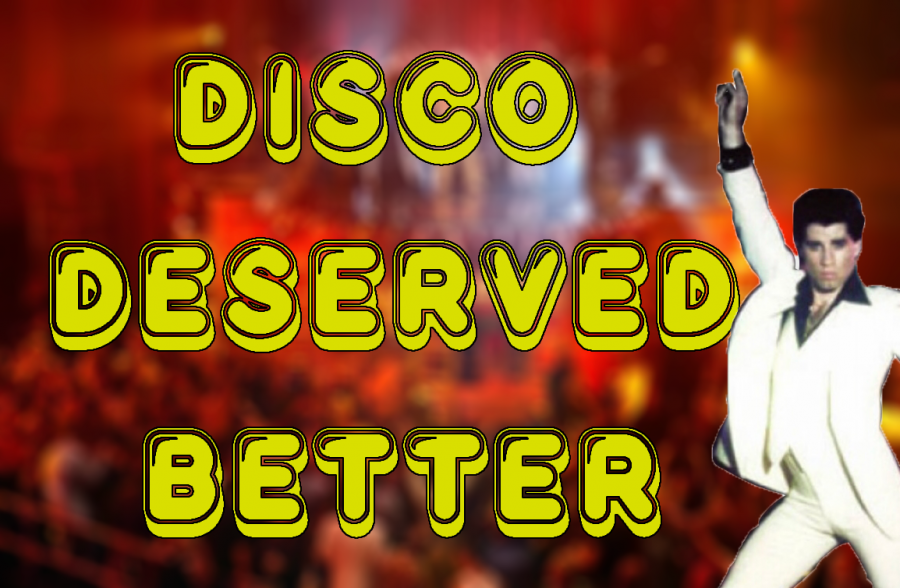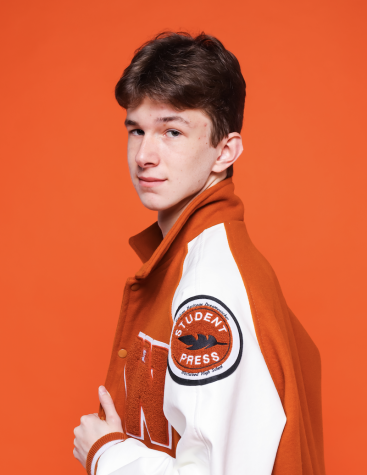Disco Deserved Better
Disco was the dominant music genre of the 1970s, but backlash quickly followed. How does it stand now, and did it deserve all the hate? Photo courtesy of Amanda Edwards and Getty Images with John Travolta from the film Saturday Night Fever, directed by John Badham.
December 14, 2020
The 1970s were a turning point for popular culture, politics, and technology. The movies weren’t quite the massive blockbusters of the ‘80s or the moldy musicals and psychedelic experiments of the ‘60s. However, we’re not here to talk about movies. We’re talking about music, and the music of the ‘70s is fantastic. I love music from basically every decade, but honestly more often than not, I find myself falling into the music of the 1970s. My favorite genre from this decade is probably the various subgenres of rock that developed, like glam, metal, soft rock, and punk, but the decade will always be associated with disco.
As someone who likes Led Zeppelin, David Bowie, and The Clash, it wouldn’t be a stretch to assume that I hate disco. Many rock and punk fans, even today, seem to hold a grudge against this flashy genre. Its glittery, flashy and danceable grooves and aesthetics were seen as too simple and brainless, as opposed to the hour long compositions of Pink Floyd. However, I happen to be a huge fan of disco. It’s music that makes me happy. Sure, it’s nothing thought-provoking, and too much of it can be irritating, but I find it to be very enjoyable. So why was this radiant genre hated at the time? Well, let’s find out.
First of all, it’s important to dissect the origin of this genre. For the most part, disco began in clubs, and not at outdoor festivals or even in the studio, like its subgenre peers. DJs would use funk songs by artists like James Brown and remix them to make them last longer, ensuring uninterrupted dancing. The pounding beat was essential for the packed floors of these clubs, which mostly sprang up around New York, but like most music genres, it is pointless to identify one song or album as the beginning of the sound. These early clubs, where disco got its start, were populated mostly by the African American and LGBTQIA+ community. Here is where I believe many music fans began their dislike of disco.
Now, I’m sure there are many people out there who don’t like disco purely because they aren’t fans of the music itself. It’s a style that won’t appeal to everyone, and I understand that completely. However, this is the 1970s, not exactly the most tolerant of time periods. It is the sad truth that many disco haters probably objected to the ethnic background of the genre, whether they were willing to admit it or not. However, this isn’t important for where we are now in the story of disco. Put a pin on it though, because it’ll be important later.
While disco began to ascend in the early ‘70s, it definitely hit its stride in 1974, before going fully commercial in 1977. Around the mid ‘70s, fans witnessed the rise of several intriguing and region specific sounds. KC and the Sunshine Band pioneered a sunny, clean style of disco that became known as the “Miami sound”.Across the world, in Europe, our foreign friends discovered the beauty of disco and put their own distinctive spin on it. Eurodisco, as it was called, was more synthesizer-driven and featured robotic, mechanical rhythms without the lush, orchestral aesthetics that many disco artists were using in the States. The two biggest artists to come out of this scene were Giorgio Moroder and ABBA. Moroder was more of a producer, recording the immortal I Feel Love with Donna Summer. It was an almost entirely synthesized production, with the only two actual live elements being Summer’s voice and a steady kick drum. Moroder was also well known as a composer of film scores. ABBA, on the other hand, was a Swedish group that used their sweet voices to great effect. Their songs were crafted with impeccable pop craft, and still prove hugely popular to this day.
1977 was the most important year of the ‘70s, and in pop culture in general. It saw the release of Star Wars, a simple sci-fi story that changed the way movies were made forever. The theme song even had a disco remix, in an odd twist of fate that intertwined the two dominant forces of the late ‘70s. 1977 also saw the birth of punk music, a raw and abrasive genre that was a reaction to the ponderous prog rock that was also popular in the decade. But to the general public, punk was nonexistent because in December 1977, disco went mainstream. It was already hugely popular, but at the end of this monumental year, even your grandma knew what disco was, all because of a little movie called Saturday Night Fever.
Directed by John Badham and starring the hunky heartthrob John Travolta, it became hugely popular with its somewhat sanitized depiction of discotheques. Based on an article about the disco scene which was later admitted to be fake by the author, and starring the impossibly cool John Travolta as Tony Manero, the film set the movie world aflame, and its soundtrack did the same for the dance floor. The Bee Gees provided some eternal classics for the film’s soundtrack, and their music is arguably the most famous music of the genre. But while it propelled the music genre into the mainstream, many original fans of the music were not happy with the film. The lead character was an Italian American who was racist and homophobic. Many fans thought he wasn’t a reflection of the real disco scene, as most hardcore fans of the genre were members of the LGBTQIA+ community or were minorities. However, I do think this is missing the point.
Manero is supposed to be an idiot who is ruining his own life. Sure, some more diversity would be nice, but the character is intended to be despicable and irritating with a glimmer of hope within his soul. Most people remember the movie today for its dazzling dance scenes, often forgetting the incredibly dark and gritty story that surrounds these scenes. It’s a depressing story centering around Manero and his morally repellent friends, who do terrible things to women and frequently spout slurs. The point of the movie isn’t really to show how great of a dancer Travolta is, no, it’s to show that despite being a great dancer, he is also a loathsome human being.
Regardless of your feelings on the film itself, there’s no denying that it helped singularly propel disco into the public consciousness. Novelty disco songs like Disco Duck began piling the charts. Disco was losing its edge.
That’s not to say that these later disco songs weren’t great. Anyone regardless of age knows Staying Alive, the lead single off of the Saturday Night Fever soundtrack. And for good reason, it’s a fantastic song and one of my favorite songs ever. The songs featured on the soundtrack were some of the best the genre had to offer, but the rot was beginning to set in.
A new movement was starting to take hold around this time too. Dubbed “Disco Sucks”, this movement was mostly spearheaded by white men who listened to classic rock. As a white guy who also listens to classic rock, I can understand someone disliking disco as a genre. It has the tendency to be repetitive and sometimes overproduced. It’s not a deep genre, and I have to be in the right mood to enjoy it. But I have a feeling that some of the people involved in this movement weren’t looking at the genre from this angle. Some likely saw that the movement was made up of mostly people different from them and had an irrational and angry reaction. Disco Sucks was definitely ignited in part by homophobia and racism.
Many of these people also hated the genre because they perceived it as being vapid, or escapist. These people probably liked Pink Floyd or The Rolling Stones, artists who incorporated interesting lyrics and a hard-edged sound into their music. Pink Floyd released 21-minute-long songs and The Rolling Stones sang about drug addiction and murder. But a funny thing happened to both of these bands. In the final two years of the 1970s, both released disco songs, both of which became massive successes. Pink Floyd was pretty far removed from disco, but let’s be honest, The Rolling Stones always had the flamboyancy and pounding beat of the genre long before disco became popular, so it was only a matter of time before these elements were incorporated.
Another Brick in the Wall Part 2 and Miss You both became massive hits, and both are still pretty good songs. But if you were a fan of these groups at the time, it must have seemed like the ultimate double cross. These artists were supposed to make “real music”, and here they were, making brainless and escapist fluff. But isn’t the whole point of music to be escapist? Music is intended to make you forget about your worries, some may find it through Pink Floyd, and others through Gloria Gaynor. The only difference is the messenger. Sure the lyrics of some disco songs were as simple as “Do the Hustle” (repeated infinitely) but artists like the Beatles had released songs where the only words said were variations of the words “Honey Pie”.
In 1979, Chicago radio host Steve Dahl was fired from his job as the DJ of a local rock station. The reason? Disco.The rock station was going to be converted into a disco station, and Dahl wasn’t happy. So he organized a “protest” to take place on July 12 at Comiskey Park, wherein during the halftime of the baseball game, disco haters could dump records on the field and burn them. Those who brought records were let in at a cheaper price and once the records were thrown, they were detonated, creating an explosion so massive that the field was unusable for some time afterwards. Riot police had to be called as Dahl’s fans stampeded the field following the explosion.
Many credit this single event as being the one that killed disco. It slowly crept off the charts after this, and while the event certainly wasn’t the only thing to “kill” disco, it was a contributing factor. But truthfully, disco never really died. In the ‘80s, artists like the Pet Shop Boys and the Talking Heads incorporated small parts of disco into their sound, and for the most part, the genre went underground, still enjoyed by a subculture of die-hard fans.
It wasn’t until the late ‘90s and the early 2000s that disco saw a cultural renewal. Daft Punk, a french duo known for their robot masks, released an album called Discovery that wore its disco influence on its sleeve, down to the title (Disco? Very!). Madonna released a hit single called Hung Up that prominently featured a sample from ABBA, one of the greatest disco bands ever. And in 2020, roller skating, a popular facet of disco culture, has become popular yet again, thanks to a viral TikTok.
Did disco die? Not really. It just receded in popularity. For years it was chronically misunderstood but luckily, it has been having a bit of a renaissance recently. The genre may not be anything deep, but the arrangements and melodies have the power to take you back to a simpler time. It’s a genre that is simultaneously simple and complex, mindless and thoughtful. I couldn’t be happier, as disco is a genre of music that never fails to cheer me up, whether it’s ABBA, The Bee Gees or Gloria Gaynor.



